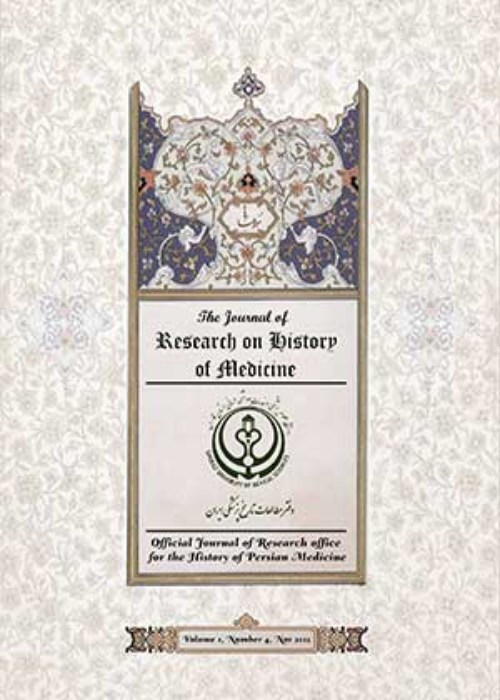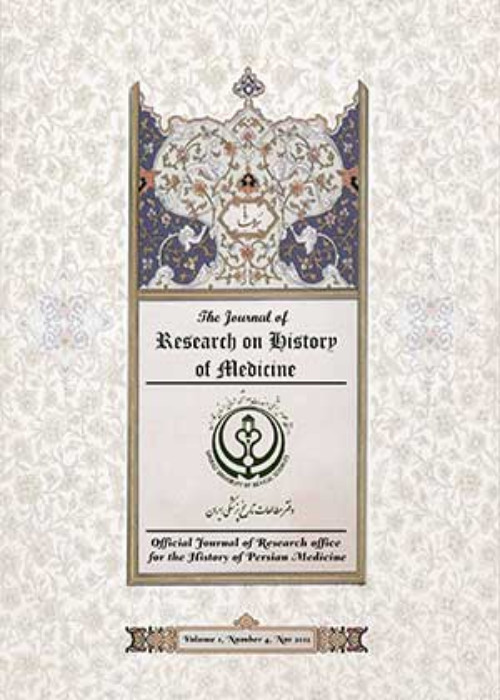فهرست مطالب

Journal of Research on History of Medicine
Volume:12 Issue: 3, Aug 2023
- تاریخ انتشار: 1402/06/05
- تعداد عناوین: 8
-
-
Pages 151-162The collection of Zend fragments is the bible of ancient Iran, which is known as the Zend-Avesta that contains some points about diseases. The aim of this documentary study is the extraction and assortment of diseases of the Zend-Avesta. To this end, each disease Avesta presented was defined as unambiguously and as briefly as possible. Finally, the findings were set and classified in the following tables. The results showed that over 70 diseases were found in the Zend-Avesta, which can be categorized into 13 groups in numerical order. The diseases found in the Zand-Avesta are as follows: unknown diseases (17), bodily defects/ infirmities (12), integumentary system (9), musculoskeletal system (7), lymphatic system (5), gynecology (5), nervous system (5), poisoning (3), related subjects (3), reproductive system (3), digestive system (2), urinary system (1), and dental disorders (1). Overall, considering the diseases collected can help us better understand the medical aspects of the sacred books.Keywords: Ancient History Medicine, Ancient Persia, Diseases & Conditions, the Zend-Avesta, Bible, Iran
-
Pages 163-172The intention of medicine is to retain and restore health and relieve suffering. Understanding pain is essential to achieving any one of these goals. It is irrefutable that every individual experiences pain in their life and is one of the commonest manifestations a physician encounters in their career. Pain makes sufferers and physicians aware of the presence of some disorders. This is the primary steps for the physician to protect the body from diseases and restore health. In addition, there is a close relationship between pain and psychological state. Pain can arise either as a consequence of physical problem or because of a psychological process. Aristotle, who associated pain with sensation, observed that where there is a sensation, there is pleasure and pain too. In addition, apparently, he regarded pain as a qualifying sensation. Relevant literary material for this paper was collected from classical Unani literature as well as modern medicine. Then, available literary material was analysed and organized systematically. This review article aims to provide a breeding ground for reflection on the concept of pain according to the Unani system of medicine and to encourage the identification of a meaningful aspect of this complex condition.Keywords: Pain, Unani System of Medicine, Waja, Alam, Avicenna, Sensation, Physicians
-
Pages 173-192Worldwide, infectious diseases have been one of the main factors of premature deaths for a long time. Due to the lack of proper social and cultural conditions, Iran suffered a lack of hygiene, particularly in provinces, until the end of the Qajar era. As Hamedan was located on the east-west transporting routes, it was exposed to infectious diseases mainly because of the presence of foreign and domestic merchants as well as traders and pilgrimage caravans. This study is to investigate the outbreak of infectious diseases in Hamedan during the Qajar period and their consequences on demographic transformations and the mortality rate. Regarding methodology, a historical, descriptive-analytic method has been used in the current study, and the data has been gathered using the documentary method. The documents and studies show that infectious diseases caused a population decrease in Hamedan province in the Qajar period. It is worth mentioning that the pandemics of infectious diseases, particularly Cholera and Plague, occurred in Hamedan during this period, one of the primary reasons for the population decrease in this province. Findings show that public ignorance, lack of proper hygiene, primitive, inappropriate routes, as well as poor performance of local and central rulers, primarily affected the increase of mortality and decrease of the population rate.Keywords: Hamedan, Qajar, Population decline, Communicable diseases, History of medicine, Iran
-
Pages 193-210The transformation of the public and individual health system from 1925 to 1941 was known as one of the pillars of the development and acceleration of the modernization process in Iran. Despite this expansion, public health and collective health, especially in schools, found a close connection with the underdevelopment of the country. Trachoma disease was one of the most common and contagious diseases among elementary school students, and the government tried to take some measures to deal with it, such as spreading public awareness, creating a skilled workforce through the training of teachers and school staff, and applying comprehensive monitoring of students’ health in the family and school. Despite these measures, there were challenges, such as a lack of medicine, a lack of skilled workforce, and financial problems that negatively affected the quality of the government’s actions. This research raises the central question: How did trachoma disease in schools become a serious issue for the government? The hypothesis is that although the government succeeded in dealing with Trachoma in primary schools, this process was gradual, slow, and temporary due to the underdevelopment of the country’s infrastructure.Keywords: Reza Shah Government, Schools, Health, trachoma, Disease
-
Pages 211-222The surgeon Anton von Eiselsberg can be regarded as one of Austria’s most influential physicians. This article presents historical materials in connection with Eiselsberg, including a letter from him sent on October 17, 1914, when World War I had already begun and the first wounded soldiers had to be treated in the field hospitals. Therefore, I focus on Eiselsberg’s role as an admiral staff physician in the Austrian Navy between 1914 and 1918. Eiselsberg’s treatment (1915 – 1917) of King Constantine I from Greece and Eiselsberg’s visit to the Osman Empire in 1918 are especially interesting and can be regarded as notable aspects of World War I history of medicine in the Middle East. In his autobiography, written in 1937, Anton von Eiselsberg clearly wrote that shots in the abdomen often could not be treated properly in World War I due to the lack of surgical capacities.Furthermore, I present biographical data of Eiselsberg’s life. The Eiselsberg family was part of Austria’s landed gentry. Anton von Eiselsberg attended a Christian Catholic monastery school as a child. This might be one of the reasons why his political positions later were often close to religious Catholic Christian conservativism.Keywords: 20th century history of medicine, World War I, Neurosurgery, General Surgery
-
Pages 223-228
Despite the availability of valuable studies on the history of medicine, the profound significance of these mediaeval outstanding medical works on the further development of medicine is underappreciated. With the present study, I intended to consider an important historical topic about advice for parents of children with epilepsy introduced by Avicenna. Interestingly, Avicenna’s advice for parents of children with epilepsy showed striking parallels between current knowledge and the text written by Avicenna, centuries before.
Keywords: Avicenna, Child, Epilepsy, Parents -
Pages 229-242Among the historical traditional medical texts, there are several hand-written manuscripts with the same structure and format on one topic. Two versions of these hand written manuscripts are under the titles of Al-Kafi Fi Al-Teb and Al-Kefaye Fi Elm Al-Teb, or briefly Al-Kefayeh which in the early sources is also referred to as Al-Qanon al-Saghir, attributed to Ibn Mandevaih. On the other hand, other versions of the Al-Qanon al- Saghir were attributed to Avicenna. Since it seems unlikely that these quite similar versions belong to two authors, it is necessary to figure out the actual writer of the work. This paper is a descriptive analysis of the existing evidence about Al-Qanon al-Saghirh and written scripts, comparing their structure and contents to similar works of Ibn Mandevaih, and Avicenna, to determine whether the author is the former or the latter, or both. After investigating historical documents, the investigators found that Al-Qanon al-Saghir was attributed to Ibn Mandevaih in early works and to Ibn-Sina in later works. The he similarities found in the structure and content of the two versions make it difficult to convince the researchers to consider each text as a separate book written by different authors. Moreover, contradictory findings presented in Al-Qanon al-Saghir to Avicenna’s famous works indicated that this book belongs to Ibn Mandevaih. The brief and comprehensive al-Qanon al-Saghir is not the summary of the extensive al-Qanon Fi Teb medical textbook by Avicenna but rather an entirely different book written by Ibn Mandevaih.Keywords: Books, Publications, Persian medicine, Avicenna, Ibn Mandevaih, Al-Qanon al-Saghir, Al-Kafi Fi Al- Teb
-
Pages 243-244


